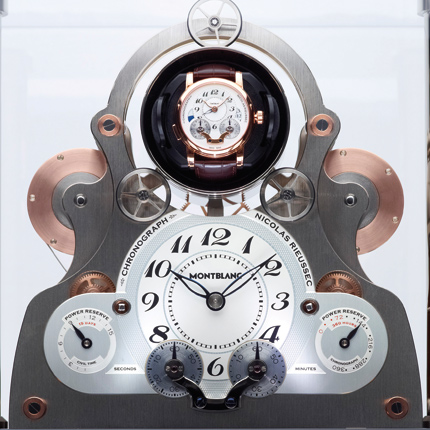
Montblanc Nicolas Rieussec Horological TimeWriter
Power reserve: 360 h, 28800 vph
-190th Anniversary of the Chronograph-
Montblanc Nicolas Rieussec Chronograph Anniversary Edition
1821 – 2011: An homage to the inventor of the chronograph
2011 will be a special year for the chronograph, which celebrates its 190th anniversary. A watch complication which is near to the heart of Montblanc, a brand which not only epitomizes the art of high-quality Swiss watchmaking, but is also the world's best-known manufacturer of fine writing instruments. Chronos means “time” and graphein means “to write.” The “time-writing” device, the first chronograph was unveiled by its inventor, Nicolas Rieussec, in 1821. He unveiled a wooden case containing a watch movement that powered two enamel dials, positioned above this one and calibrated with scales for the seconds and the minutes. Above these dials he had affixed a slender hand with ink-filled nibs attached to its tip. While the dials turned, the timekeeper at a race could press a button the instant a horse crossed the finish line, thus triggering the hands to touch the dials and leave little ink marks on them. The running times of the individual horses and the time differences were literally written on the dials. This was the first time in the history of horology that an instrument could measure precise short time intervals. Inspired by the notion “Writing time”, he called his invention “Chronograph”.
Montblanc first paid homage to the inventor of the device for measuring brief intervals of time by dedicating its innovative Montblanc Nicolas Rieussec Chronograph to the ingenious watchmaker in 2008. As on the original chronograph from 1821, the chronograph hands do not rotate above the dials; instead, they remain motionless while the seconds-disk and minutes-disk turn underneath them. With this, Montblanc created a new face to the chronograph combining tradition with innovation. The Rieussec chronograph is the first chronograph where the time display does not interact with the chronograph function. Thus, providing better legibility of both indications and giving the watch a strong, unique look. All subsequent Nicolas Rieussec Chronographs from Montblanc have followed this same principle. For the 190th anniversary in 2011, the watch manufacture in the Swiss watchmaking centre of Le Locle now launches the
Montblanc Nicolas Rieussec Chronograph Anniversary Edition, which will be available in a strictly limited editions of 190 watches in eighteen carat red gold, 90 watches in eighteen carat white gold and 25 watches in 950 platinum.
Typically Montblanc Nicolas Rieussec
A very subtle and pure, yet classique guilloche pattern gives emphasis to the watches iconic features. An hours-circle displays the ordinary time of day: this subdial is off-centred toward the “12 o'clock” position of the main dial and held firmly in place by blued screws. The unique “smiling” V-shaped bridge holds the ruby counter-bearings for the two chronograph-disks: the subdial at the left can tally up to sixty elapsed seconds, while the disk at the right can count a maximum of thirty elapsed minutes. Below the hour-hand and minute-hand turns a finely skeletonized date-disk.
The periphery of the dial is adorned with a finely grained guilloche pattern known as “grain de seigle.”
A Chronograph Manufacture Movement
The MB R110 calibre assembled from 263 individual parts unites all the important features of the history of the chronograph. These include classical column-wheel control, as well as a modern and nearly friction-free vertical coupling which prevents wear when the chronograph function is allowed to run for a lengthy period of time. The rapid-reset mechanism for the hour and date is extremely practical for travellers who journey from one time zone to another. These indicators can be reset either clockwise or counter-clockwise and without affecting the position of the minute-hand. The hand-wound Montblanc manufacture movement has two barrels which together amass a 72-hour power reserve. To enhance precision and assure the stability of the watch's rate, the balance has a moment of inertia of 12 mg/cm2 and oscillates at a pace of 28,800 semi-oscillations per hour (4 Hz).


